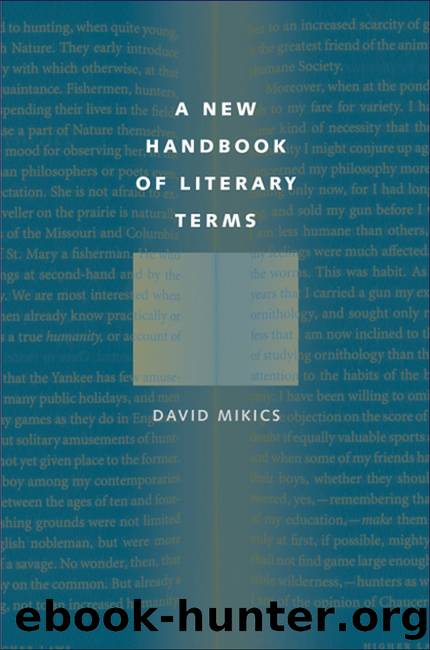A New Handbook of Literary Terms by Mikics David

Author:Mikics, David [Mikics, David]
Language: eng
Format: epub
ISBN: 9780300135220
Publisher: YaleUP
Published: 2007-09-15T05:00:00+00:00
M
mannerism A mannerist art work is marked by refinement and grace, polished high style, and (often) a courtly reserve. In the visual arts, its usual home, mannerism succeeds the pure, classical Renaissance mode of Raphael; it can be seen in the paintings of Bronzino and Parmigianino, and in much of Michelangelo. James Mirollo in Mannerism and Renaissance Poetry (1984), following E. R. Curtius, European Literature and the Latin Middle Ages (1948), makes a case for the usefulness of mannerism as a literary category, to describe works of elegant artificiality. An excellent general study of the subject is John Shearmanâs Mannerism (1967). See also S. J. Freedbergâs magisterial Painting in Italy, 1500 -1600 (1971). For a related concept, see BAROQUE.
Marxist literary criticism The tradition of Marxist literary criticism begins in a minor way with Karl Marx and Friedrich Engels themselves. In their book The Holy Family (1844- 45), Marx and Engels ridiculed the melodramatic French novelist Eugène Sue (1804 - 57) as a spokesman for bourgeois ideology. But, as Edmund Wilson notes, Marx loved and admired great poetry, from Aeschylus to Shakespeare to Heine, and he had very little interest in reducing it to an expression of socioeconomic forces. The tradition of Marxist literary criticism proper begins long after Marx and Engels, with figures like Leon Trotsky (1879 -1940), Theodor Adorno (1903 - 69), and Bertolt Brecht (1898 -1956).
There are two major tendencies in Marxist literary criticism. First is the idea that a societyâs literature and art can be understood as a result, or reflection, of its economic and class-based arrangements (its ârelations of productionâ). Second is the assertion that literature should be evaluated in terms of its effectiveness as a weapon of class struggle.
The latter notion, of books as a kind of working-class propaganda, was popular among intellectuals in the United States during the 1930s, when Stalinism was a substantial influence. Periodicals like the New Masses judged writers according to whether they were more, or less, useful for the coming revolution. In Soviet Russia, the doctrine of socialist realism held sway, with its insistence on the need to represent workers in heroic terms. But such views of literature as a mere weapon in a propaganda war now seem quaint and repulsive. (See AGITPROP; SOCIALIST REALISM.)
In Literature and Revolution (1924), Trotsky, one of the leaders of the Russian Revolution, expressed skepticism about the idea of a proletarian literature that would replace bourgeois forms. Yet Trotsky, in the same book, also scorned formal experimentation for its own sake, and underlined the need for writers to be committed to the revolution in their work. (Trotsky was not unfriendly to the avant-garde; in 1938, while in exile in Mexico, he coauthored a pamphlet with the Surrealist André Breton.) The playwright Bertolt Brecht, like Trotsky, argued that a Marxist author should dedicate himself, before all else, to representing class struggle.
Theodor Adorno and Georg Lukács (1885-1971), the two preeminent Marxist critics of the twentieth century, were less interested in finding in literature signs of the authorâs political commitments.
Download
This site does not store any files on its server. We only index and link to content provided by other sites. Please contact the content providers to delete copyright contents if any and email us, we'll remove relevant links or contents immediately.
The Power of Myth by Joseph Campbell & Bill Moyers(1002)
Half Moon Bay by Jonathan Kellerman & Jesse Kellerman(953)
A Social History of the Media by Peter Burke & Peter Burke(935)
Inseparable by Emma Donoghue(922)
The Nets of Modernism: Henry James, Virginia Woolf, James Joyce, and Sigmund Freud by Maud Ellmann(833)
The Spike by Mark Humphries;(765)
The Complete Correspondence 1928-1940 by Theodor W. Adorno & Walter Benjamin(746)
A Theory of Narrative Drawing by Simon Grennan(742)
Culture by Terry Eagleton(713)
Ideology by Eagleton Terry;(696)
Bodies from the Library 3 by Tony Medawar(680)
World Philology by(674)
Farnsworth's Classical English Rhetoric by Ward Farnsworth(673)
Game of Thrones and Philosophy by William Irwin(669)
High Albania by M. Edith Durham(654)
Adam Smith by Jonathan Conlin(648)
A Reader’s Companion to J. D. Salinger’s The Catcher in the Rye by Peter Beidler(646)
Comic Genius: Portraits of Funny People by(616)
Monkey King by Wu Cheng'en(609)
